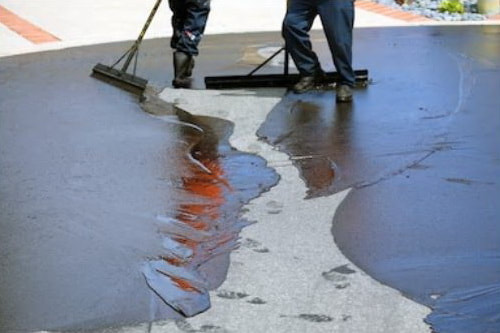Prolong Pavement Lifespan: Ingenious Cold Mix Asphalt Sealing
Prolong Pavement Lifespan: Ingenious Cold Mix Asphalt Sealing
Blog Article
Cold Mix Asphalt Vs. Hot Mix Asphalt: Which Is Right for You?
:max_bytes(150000):strip_icc()/barricade-tape-sealed-driveway-big-56a583145f9b58b7d0dd3d87.jpg)
Structure Differences
Cold mix asphalt is created by emulsifying the asphalt binder with water and an emulsifying representative before mixing it with aggregate. The warm mix asphalt manufacturing procedure includes heating the accumulation and asphalt binder independently before combining them at the asphalt plant.
In addition, cold mix asphalt tends to be much less dense and more versatile than hot mix asphalt. This versatility makes it much better fit for areas with higher levels of movement, such as driveways or roadways with rush hour. In contrast, hot mix asphalt is understood for its high resilience and resistance to rutting and cracking, making it a favored option for freeways and high-traffic roads where longevity is crucial.
Setup Process Differences
The process of installing cold mix and warm mix asphalt exhibits significant differences in their treatments and demands. Cold mix asphalt, being an extra flexible product, can be applied straight from the bag or container onto the split or harmed location. It needs marginal preparation job, such as cleaning the location and condensing the cool mix with hand tools. This makes it a convenient option for fast and momentary repairs. In contrast, warm mix asphalt requires a more fancy setup process. It entails heating up the mixture to high temperature levels before laying it down on a properly ready base. The preparation consists of compacting the base, applying a tack coat, and using hefty equipment like pavers and compactors for a long lasting and smooth surface. As a result of the heating needs, hot mix asphalt setups are typically executed by specialists with specialized devices, ensuring a more structurally sound and irreversible result.
Resilience and Longevity Aspects
When taking into consideration asphalt choices, toughness and durability are critical elements to examine for long-term sidewalk performance. Warm mix asphalt (HMA) is known for its extraordinary durability and long life.
In regards to long life, HMA usually exceeds CMA because of its superior toughness and resistance residential or commercial properties. HMA pavements have a longer service life, requiring much less frequent repairs and maintenance, which can translate to cost financial savings over time. In addition, HMA sidewalks are extra easily adjustable to meet specific project needs, further enhancing their resilience.
Price Factors To Consider
Taking into consideration the financial implications is a critical aspect when examining the choice between warm mix asphalt (HMA) and cold mix asphalt (CMA) for sidewalk tasks. While the initial price of warm mix asphalt is generally more than that of cool mix asphalt, HMA typically gives a more affordable remedy in the lengthy run because of its remarkable durability and durability. HMA is understood for its capability to hold up against rush hour tons and extreme climate condition, minimizing the need for constant repair services and upkeep. On the other hand, chilly mix asphalt is extra inexpensive ahead of time yet might require even more frequent patching and resurfacing, leading to higher upkeep expenses with time.
In addition to product costs, it's necessary to take into consideration the expenses connected with installation and upkeep when comparing HMA and CMA. Inevitably, the choice in between HMA and CMA should take right into account not simply the initial expense but likewise the long-term monetary ramifications to identify the most cost-effective option for the particular pavement task.
Environmental Influence Comparison
Contrast of the ecological influences in between warm mix asphalt (HMA) and cold mix asphalt (CMA) reveals unique differences in sustainability methods. HMA production requires high temperatures, causing boosted power usage and greenhouse gas exhausts. The process likewise releases unstable organic compounds (VOCs) and unsafe air contaminants (HAPs) into the ambience. On the other hand, CMA is created and used at lower temperatures, lowering energy use and discharges considerably. The reduced production temperature levels of CMA cause decreased fuel consumption and lower degrees of CO2 emissions, making it an extra eco friendly option.
In addition, the usage of CMA commonly entails recycling existing asphalt sidewalk, advertising resource conservation and reducing the quantity of waste sent to landfills. By opting for CMA over HMA, road building and construction tasks can contribute positively to environmental conservation initiatives.
Verdict
In conclusion, the selection in between cold mix asphalt (CMA) and angle parking warm mix asphalt (HMA) depends upon different aspects such as composition, installment process, longevity, long life, expense, and environmental impact. cold mix asphalt. While CMA offers a fast and cost-efficient remedy for small repair services, HMA ensures remarkable toughness and longevity for rush hour areas. Think about these aspects very carefully to establish which sort of asphalt is the best selection for your paving needs

Taking into consideration the economic ramifications is a vital aspect when examining the option between hot mix asphalt (HMA) and cold mix asphalt (CMA) for sidewalk jobs. While the preliminary cost of hot mix asphalt is commonly greater than that of cool mix asphalt, HMA frequently provides a more affordable remedy in the long run due to its remarkable sturdiness and durability. angle parking.Contrast of the environmental impacts in between hot mix asphalt (HMA) and chilly mix asphalt (CMA) discloses distinctive distinctions in sustainability practices.In final thought, the option in between cool mix asphalt (CMA) and warm mix asphalt (HMA) depends on numerous variables such as make-up, installation process, longevity, durability, expense, and ecological impact
Report this page